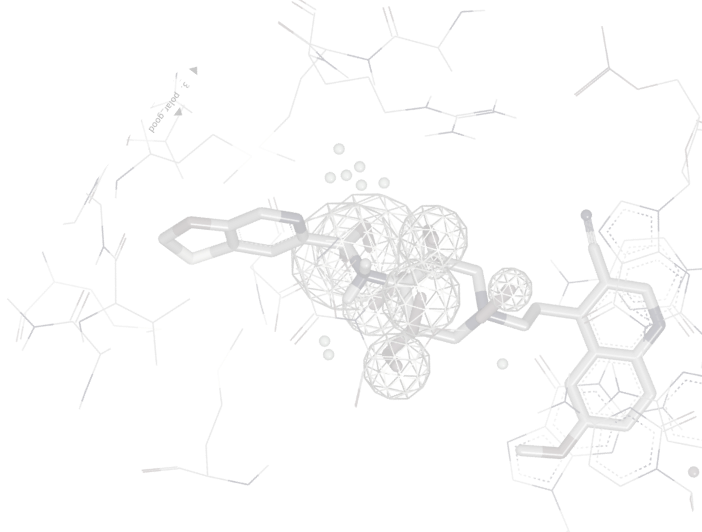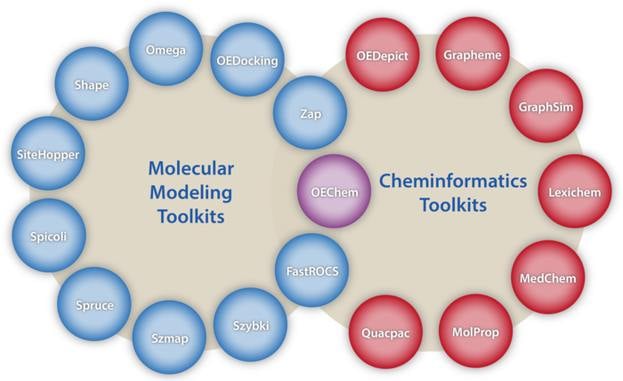
MedChem TK
MedChem TK provides a powerful fragmentation-based analysis engine that prospectively identifies matched molecular pairs [1] that differ by both heavy-atom and hydrogen-atom substitutions. Matched molecular pairs are a compelling concept used to identify changes in properties of interest accompanying a localized structural change. Additionally, matched pair transformations provide the ability to use alternate structure sources for the generation of new leads and delta-property estimates based on the ensemble of matched structural pairs associated with each transformation.
Utilities that provide the ability to fragment structures [2] into smaller building blocks are useful for the identification and characterization of new building blocks for lead analysis or docking and evaluation. A number of different fragmentation strategies are provided to aid this activity in MedChem TK.
Additional functions are available which provide molecular complexity [3,4] metrics. Molecular complexity is useful for scoring or filtering of candidates or for clustering and ranking molecular structures.
For more information on MedChem TK, check out the link below:

Cheminformatics
The Cheminformatics suite of toolkits provides the core foundation upon which all the OpenEye applications and remaining toolkits are built.
- OEChem TK Core chemistry handling and representation as well as molecule file I/O
- OEDepict TK 2D Molecule rendering and depiction
- Grapheme™ TK Advanced molecule rendering and report generation
- GraphSim TK 2D molecular similarity (e.g. fingerprints)
- Lexichem TK name-to-structure, structure-to-name, foreign language translation
- MolProp TK Molecular property calculation and filtering
- Quacpac TK Tautomer enumeration and charge assignment
- MedChem TK Matched molecular pair analysis, fragmentation utilities, and molecular complexity metrics
Modeling
The Modeling suite of toolkits provides the core functionality underlying OpenEye's defining principle that shape & electrostatics are the two fundamental descriptors determining intermolecular interactions. Many of the toolkits in the Modeling suite are directly associated with specific OpenEye applications and can, therefore be used to create new or extend existing functionality associated with those applications.
- OEChem TK Core chemistry handling and representation as well as molecule file I/O
- FastROCS™ TK Real-time shape similarity for virtual screening, lead hopping & shape clustering
- OEDocking TK Molecular docking and scoring
- Omega TK Conformer generation
- Shape TK 3D shape description, optimization, and overlap
- SiteHopper TK Rapid Comparison of Protein Binding Sites
- Spicoli TK Surface generation, manipulation, and interrogation
- Spruce TK Protein preparation and modeling
- Szybki TK General purpose optimization with MMFF94
- Szmap TK Understanding water interactions in a binding site
- Zap TK Calculate Poisson-Boltzmann electrostatic potentials
References
- Computationally Efficient Algorithm to Identify Matched Molecular Pairs (MMPs) in Large Data Sets, Hussain, J., Rea, C., J. Chem. Inf. Model., 2010, 50, 339.
- The Properties of Known Drugs: 1. Molecular Frameworks, Bemis, G.W., Murcko, M.A., J. Med. Chem. 1996, 39, 2887.
- The First General Index of Molecular Complexity, Bertz, S.H., J. Am. Chem. Soc., 1981, 103, 3599.
- Structure and Reaction Based Evaluation of Synthetic Accessibility, Boda, K., Seidel, T., Gasteiger, J., J. Comp.-Aided Mol. Design, 2007, 21, 311.
RESOURCES
